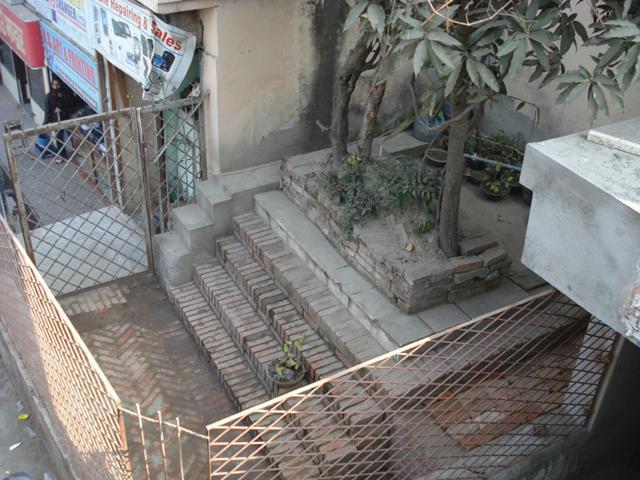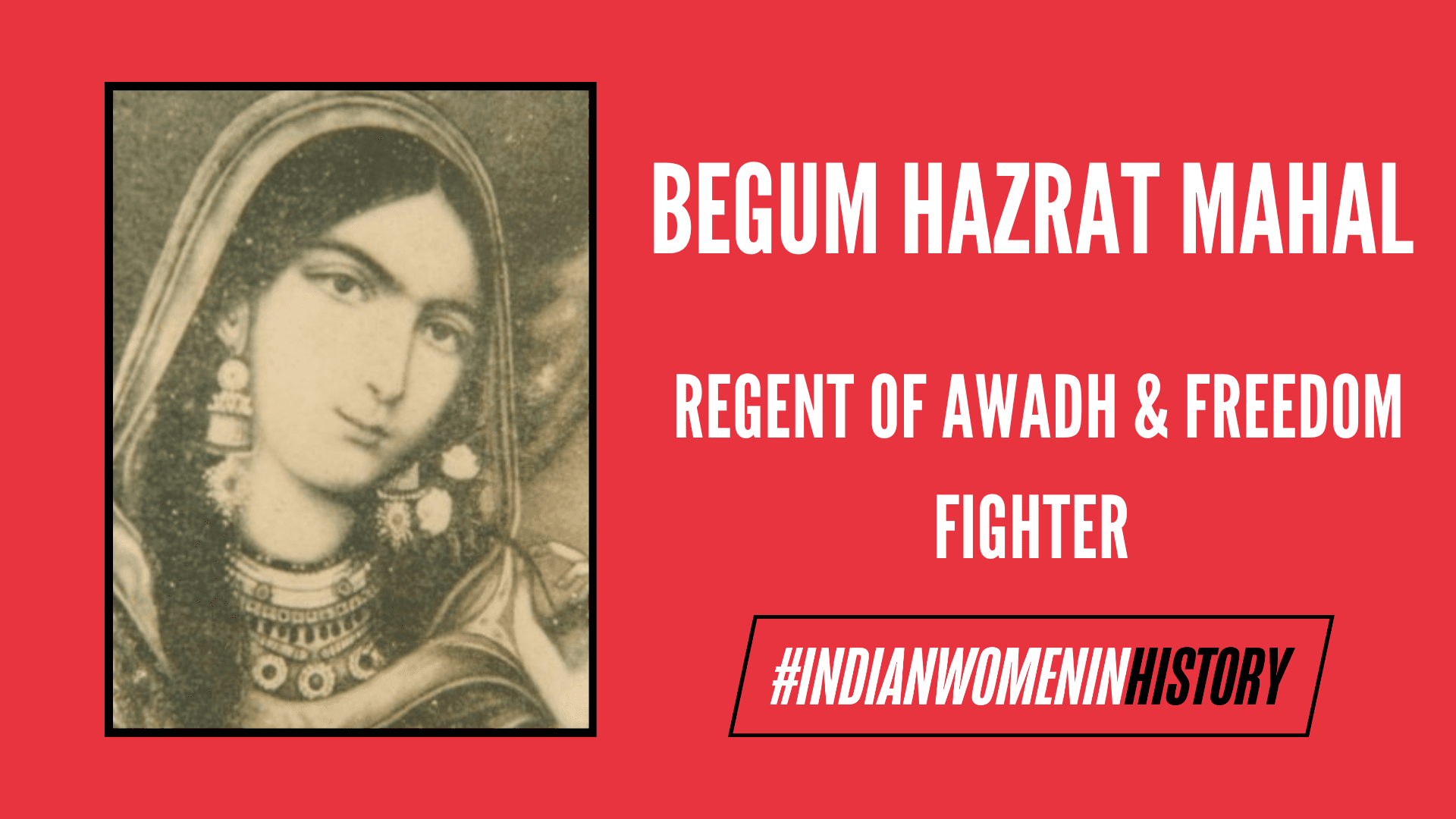Overshadowed by the glorious accounts of Rani Lakshmi Bai, our history books hardly had any account of Begum Hazrat Mahal, also known as the ‘Begum of Awadh‘. She took a rebellious stand against the British East India Company and the British Empire.
Early life
Born in an economically disadvantaged family in 1820, Hazrat Mahal was a courtesan by profession. Her maiden name had been Muhammadi Khanum. She was born in Faizabad, Awadh. After being sold to the royal Awadh harem as a khawasin (an attendant), she soon caught the attention of the last Tajdar-e-Awadh, Nawab Wajid Ali Shah.
She was soon promoted to a ‘pari’ (fairy) from a khawasin. Pari meant a group of women (the idea of which was introduced by the Nawab himself) where women from economically disadvantaged groups were trained and educated with different art and performance skills to please the Nawab. They were also considered to be the temporary wives of the Nawab.
She was titled with ‘Mahak Pari’ (fragrant fairy) by the Nawab. She was one of his concubines. The Nawab named her Iftakar-un-Nisa and she became the second wife of Wajid Ali Shah. As soon she gave birth to their son, the Prince of Awadh, Birjis Qadr, she was titled Begum Hazrat Mahal (Royal Queen). But she too was divorced by the Nawab like his other concubines.
The British East India Company and Awadh
In 1856, by the means of the Doctrine of Lapse introduced by Lord Dalhousie, the East India Company annexed the kingdom of Awadh. Awadh as a territory was a great resource for cotton and indigo. They appropriated Awadh on the basis of debauchery and gross mismanagement of revenue.
Nawab Wajid Ali Shah was exiled from his throne and was sent to Calcutta (Metiabruz) with a part of his family in March 1856. Begum Hazrat Mahal and other divorced concubines were left behind in Lucknow. Begum Hazrat Mahal took the charge of Awadh and their 12-year son. Prince Birjis Qadr was officially crowned at the Baradari, Qaisebagh.
She ruled as a regent for 10 months. As a Begum from an enormous royal family, she broke the stereotypes of her gender performances and revolted against the British East India Company in the Great Mutiny of 1857.

During the first war of independence against the British, Lucknow was one of the most bitterly contested constitutions in India. Begum Hazrat Mahal did choose not to succumb to the East India Company. Soon, Queen Victoria, in order to formally transfer the British territory of India from the East India Company to the British Crown made a proclamation – Hazrat Mahal made a counter proclamation and refused to abide by the conditioning.
She motivated the population of Awadh and led a ‘peasants in uniform’ military rebellion in Awadh. It turned into a general uprising of people. She was successful at creating a harmonized equation and established social equality between people of all castes and religion.
The freedom of Awadh was never her only concern. Instead, she aspired towards freedom for India. She used to ride on an elephant and be physically present at the battleground to encourage soldiers against the advancing British troops. Nana Sahib (the childhood friend of Rani Lakshmi Bai) was one of her confidants. She worked in close association with him.
Also Read: Uda Devi: Dalit Freedom Fighter In The 1857 Uprising | #IndianWomenInHistory
Soon the British overpowered Lucknow and the freedom fighters with their qualitatively better war equipment. Begum Hazrat Mahal refused a pension offered by the English royalty and moved from Lucknow.
There she joined the Maulavi of Faizabad and continued organising guerrilla attacks on British military centres till November 1859. The attack in Sahajahanpur is one of them. Sir Henry Lawrence (the Chief Commissioner of Awadh) conceded defeat in a decisive battle at Chinhat fought the same year.
Later years
Hazrat Mahal finally sought refuge in Nepal. Then Prime Minister of Nepal, Rana Jang Bahadur, allowed her refuge and there she spent the last years of her life.

She died in the year 1879 and was buried in Kathmandu, near the Jama Masjid. Her grave was found to be in a very poor condition, which is now under the custody of the Jama Masjid Committee.
Begum Hazrat Mahal’s legacy
She proved to be a far better ruler and leader than the Nawab himself. She was an intuitive politician with incredible military and administrative abilities. There have been accounts of her parents where her father was slave and mother was a mistress, though there are hardly any accounts available of her early life as such.
After being sold to the royal harem, she lived the life of a courtesan. But it is known through oral historical tradition that she dismissed those from her royal audience who were being disrespectful towards her, during her performances.
The demand for dignity was one of the primary things Begun Hazrat Mahal fought for, from her admirers at the court from enemies she fought against. She also mobilized other courtesans to fight on the battlefield and they equally participated in the war against the British.
Selective historical education
The Indian history of independence with its mainstream approach towards representation has perhaps strategically ignored her for her Muslim identity and for her non-royal background. A khawasin, then a courtesan, becoming the Begum of Awadh and finally taking a rebellious stand against the powerful British – Begum Hazrat Mahal did not conform to the idea of an ideal Indian Queen with codes of conduct and coyness. Historically, she has been overlooked and overshadowed by her contemporaries.
Memoirs
Recently, while working on a different project, filmmaker Mohi-ud Din Mirza found many references about the formidable leader during his research in the India House Library in London. He decided to document her life. He made a 26 minute documentary on her, produced by Films Division India.

The Victoria Park in Hazratganj, Lucknow had been renamed after her as Begum Hazrat Mahal Park in 1962. After keeping her away widespread recognition for a very long time, the Indian Government issued a commemorative stamp on 10th of May 1984, in honour of Begum Hazrat Mahal.
The entire city of Lucknow and the kingdom of Awadh united under the leadership of Begum Hazrat Mahal to stand up against the British, in the first war of independence, irrespective of religious and gender differences. The glory of her passion towards freedom and survival made her iconic in history.
Also Read: Jhalkari Bai: The Indian Rebellion Of 1857 And Forgotten Dalit History | #IndianWomenInHistory
Featured Image Credit: Dailyhunt
About the author(s)
Gender Fluid. Queer. Feminist. Activist. Writer. Poet. Dreamer.





very interesting and informative article, although repetitions could have been avoided.